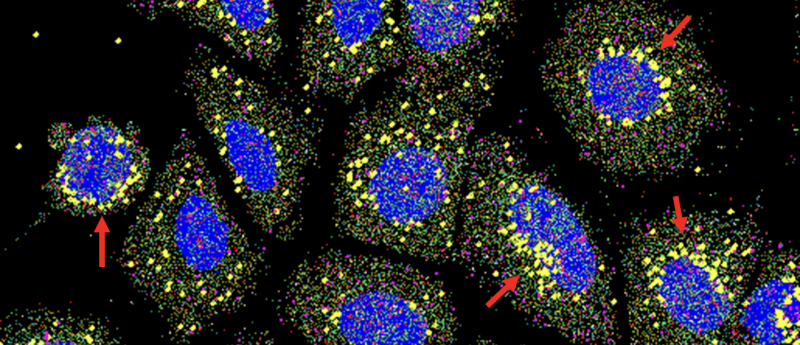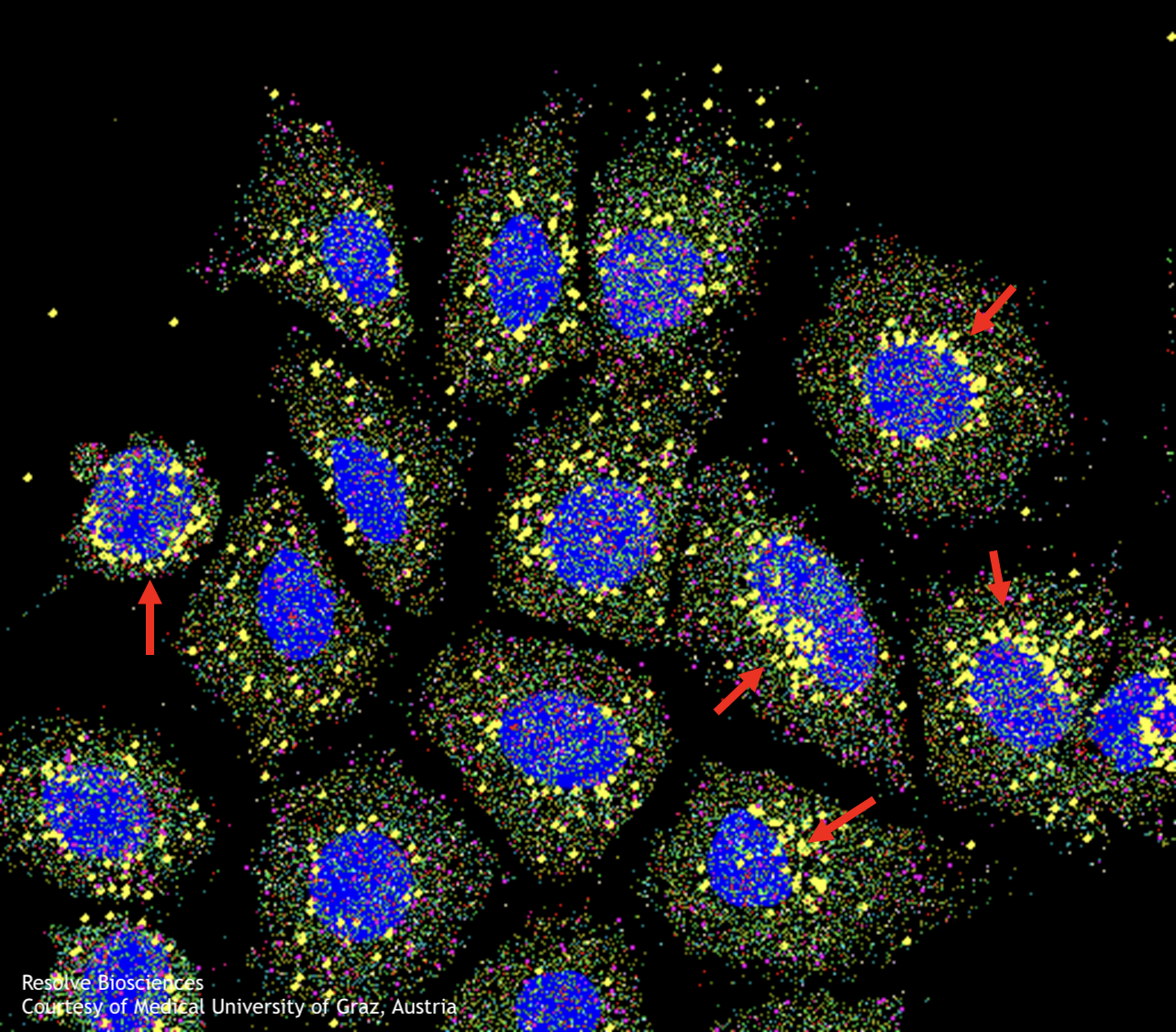Resolve Biosciences Announces Initial Results from Early Access Collaborations with Scientists Leading the Next Generation of Subcellular Spatial Analysis

The power and resolution of the Molecular Cartography platform is illuminating important cellular interactions in COVID-19 pathology, neurology and developmental biology research
MONHEIM AM RHEIN, Germany – Feb. 22, 2021 – Resolve Biosciences, the pioneer in Molecular Cartography, today announced initial results from several prominent early access collaborations with leading laboratories across Europe. Teams of scientists are currently using the groundbreaking subcellular spatial analysis technology to help resolve daunting challenges in COVID-19 pathology, neurology, and developmental biology research.

In the image to the left, SARS-CoV-2 transcripts of the nucleocapsid protein (shown in yellow) are predominantly found close to the cell nucleus. Interestingly, some cells show a polar localization of SARS-CoV-2 transcripts (red arrows). Transcripts of 80 other genes (marked in different colors) are distributed throughout the cell. The Resolve Biosciences Molecular Cartography technology enabled scientists to compare infected and non-infected cells to understand subcellular gene regulation and how the infection affects neighboring cells over time.
Under development since 2016, Resolve’s Molecular Cartography platform features the company’s proprietary, highly multiplexed, single-molecule detection technology to provide the highest-resolution view of subcellular transcriptomic activity. Unlike other spatial analysis techniques, the Resolve platform provides the required sensitivity, specificity, and workflow convenience to elucidate the cell’s complex transcriptional landscape. The technology generates deep contextual data sets that illuminate molecular interactions at subcellular resolution while preserving the sample tissue for future analysis.
The Resolve Molecular Cartography platform has been available through an oversubscribed early access program during the past year. Initial findings from several of the high-profile projects include:
- SARS-CoV-2 Infection and Inflammatory Response — Medical University of Graz, Austria
The laboratory led by Kurt Zatloukal, MD, Professor of Pathology and Head of the Diagnostic and Research Center for Molecular Biomedicine, is using the Molecular Cartography platform to study the molecular pathology behind SARS-CoV-2 infection and the subsequent inflammatory response on the mRNA level that leads to severe disease. The Resolve technology offers the ability to explore the distribution of infected cells, their morphology, and molecular activity at the same time. The team analyzed different cell culture systems to compare the transcriptomic activity of more than 80 genes in infected cells and non-infected cells, explore how cells react to changes in gene expression upon viral infection, analyze the exact position of transcripts within cells, and investigate how the antiviral host response can trigger tissue damage. The initial results have provided a better understanding of subcellular gene regulation and how the infection affects neighboring cells over time. - Human Brain Development — MRC Laboratory of Molecular Biology, Cambridge, UK
Madeline A. Lancaster, PhD, Group Leader in the Cell Biology Division, and her team are applying the power of Molecular Cartography to brain organoids to unravel the spatial logic of neural tissue development. Since the technology reliably captures spatiotemporal gene expression, researchers can study key aspects of human brain function and development in vitro. The team used the technology to detect and quantify expression with ultra-high sensitivity, showing 100 gene transcripts simultaneously at subcellular resolution. The initial results suggest that the spatial distribution of mRNA molecules for outer radial glia (oRG) cell markers is not confined to the outer subventricular zone but rather is spread throughout the whole proliferative ventricular zone. This observation highlights the necessity to look for more specific oRG markers to be applied in the context of brain organoids. - Retina Gene Expression and Cell Type Evolution — University College London, UK
Ryan MacDonald, PhD, Biotechnology and Biological Sciences Research Council David Phillips Fellow and Lecturer at the Institute of Ophthalmology, and his colleagues are using Molecular Cartography technology to better understand how a healthy retina develops and changes with advancing age. Scientists were able to visualize the spatial expression of 48 genes simultaneously in the same zebrafish sample to observe the development of different cell types using specific marker genes in the retina. Then by visualizing gene expression changes over the entire lifespan, specifically within the support cells called glia, they were able to identify candidate genes that are dysregulated in the aging retina and potentially underlie progressive neuronal degeneration and vision loss.
“Thanks to its exquisite resolution, the technology from Resolve Biosciences allows us to detect specific gene expression patterns in SARS-CoV-2 that we could not see with existing RNA sequencing or single-cell RNA-seq technologies,” said Prof. Zatloukal. “Since the Resolve workflow provides spatial information at subcellular resolution and still preserves the tissue integrity, we see clear clinical opportunities with this approach moving forward.”
“Over the past year, Resolve Biosciences has had the privilege of working with many of the true visionaries of single-cell and spatial biology,” said Jason T. Gammack, Co-founder and CEO of Resolve Biosciences. “We are grateful for their engagement and feedback, and proud that they were able to gain new insights that were not possible with alternative approaches. We look forward to empowering more scientists around the world with this same ability to rapidly advance the understanding of complex biology with our novel Molecular Cartography platform.”
Resolve Biosciences is now expanding its early access program globally. Scientists interested in learning more about how to access and apply the power of its innovative Molecular Cartography technology can contact the company.